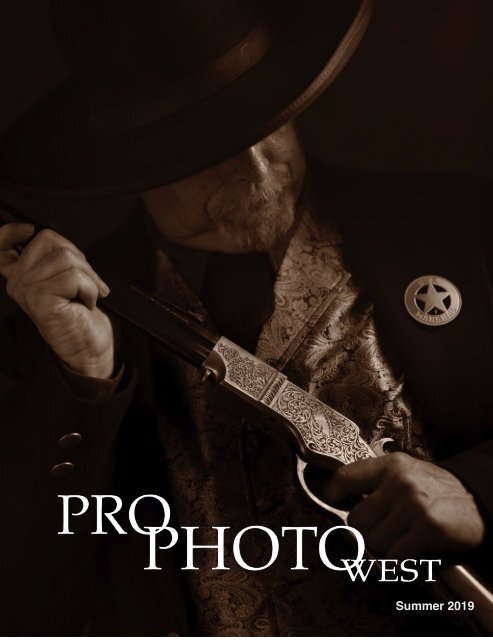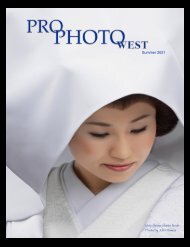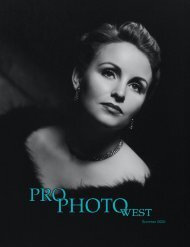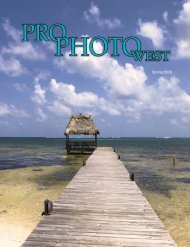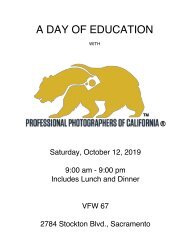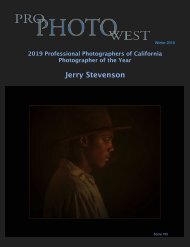Pro Photo West Magazine Summer 2019
You also want an ePaper? Increase the reach of your titles
YUMPU automatically turns print PDFs into web optimized ePapers that Google loves.
<strong>Summer</strong> <strong>2019</strong>
INSIDE THIS ISSUE<br />
6<br />
Letter from<br />
Editor’s Message<br />
the Editor<br />
President’s<br />
Meet Your Executive Team<br />
8 10 Gadget Girl<br />
Message 11<br />
16<br />
California Business & Arts Degree<br />
24<br />
2020 PPC State Image Competition<br />
<strong>Pro</strong>fessional <strong>Photo</strong>graphers of California
SUMMER <strong>2019</strong><br />
Meet your Affiliates<br />
18 California Worshops 20<br />
Bucket List -<br />
<strong>Photo</strong> Essay<br />
22 Meet your Affiliates<br />
30<br />
Variations on<br />
Portrait Lighting<br />
28<br />
<strong>Photo</strong>-Biz 101<br />
32<br />
<strong>2019</strong> WCS - Tha’s A Wrap!<br />
www.prophotoca.com <strong>Summer</strong> <strong>2019</strong>
A Message From the Editor<br />
This <strong>Summer</strong> <strong>2019</strong> is our 4 th issue of <strong>Pro</strong> <strong>Photo</strong> <strong>West</strong> <strong>Magazine</strong> since we brought it back for you. I cannot<br />
believe it has been a whole year!!!!<br />
First of all, let me thank all of you - for participating, proofing, viewing, reading and sharing. Without you, this<br />
would not have happended. On that note, we still need your help. We are always looking for articles. It doesn’t<br />
necessarily have to be photography related, How about a great recipe, or a quick photo hack? Send them in! We<br />
will have all the publishing information on the PPC website in the very near future. If you have any questions<br />
please email editor@ppconline.com<br />
Did you know that you can earn PPC Service Merits if your article is published? How cool is that! If you have an<br />
article that you would like to submit, send it to editor@ppconline.com.<br />
Ok, so now it is time to get down to business. Here it is…this will be our last issue where advertising by any<br />
vendor will be complimentary. Starting with our November first issue, we have set in place new advertising rates<br />
for <strong>Pro</strong> <strong>Photo</strong> <strong>West</strong> <strong>Magazine</strong>.<br />
Two Page Spread<br />
Full Page<br />
Half Page<br />
1/3 Page<br />
1/4 Page<br />
$ 1200.00<br />
$ 750.00<br />
$ 500.00<br />
$ 300.00<br />
$ 250.00<br />
These rates are per year and include ad placement in 4 issues per year. The advertiser must supply the ad(s) for<br />
the year. <strong>Pro</strong> <strong>Photo</strong> <strong>West</strong> does not design advertisements. The advertiser may choose to run the same ad or<br />
change per magazine issue. Ads must be submitted by the following ad deadlines and submitted to<br />
editor@ppconline.com<br />
October 1 for the November 1 issue<br />
January 1 for the February 1 issue<br />
April 1 for the May 1 issue<br />
July 1 for the August 1 issue<br />
I want to thank all of you who have participated in one way or another! With out you, this could not have been<br />
possible!<br />
ON THE COVER<br />
Paul taken by Tim Meyer at <strong>West</strong> Coast School of <strong>Photo</strong>graphy. Paul was one of the wonderful models at WCS. While<br />
teaching his class, Tim took full advantage of Paul in his authentic western wear.
A Huge Thank You to Our Sponsors!<br />
Your Support is Greatly Appreciated!<br />
7
<strong>2019</strong> OFFICERS<br />
PRESIDENT<br />
Pete Rezac, M.<strong>Photo</strong>g.Cr, CPP,<br />
M-PPC, S-PPC<br />
president@ppconline.com<br />
FIRST VICE PRESIDENT<br />
Jim Trapp, M.<strong>Photo</strong>g.Cr, CPP<br />
S-PPC<br />
firstvp@ppconline.com<br />
SECOND VICE PRESIDENT<br />
Diane Costello, M.<strong>Photo</strong>g.Cr, CPP<br />
M-PPC, S-PPC<br />
<strong>Pro</strong>fessional <strong>Photo</strong>graphers of California, Inc. is a non-profit, 501(c)6<br />
trade association of professional photographers, employees, suppliers<br />
and others allied to the profession. <strong>Pro</strong>fessional <strong>Photo</strong>graphers of<br />
California offers a variety of opportunities and benefits to its Members and<br />
is one of the largest state affiliates of <strong>Pro</strong>fessional <strong>Photo</strong>graphers of<br />
America. <strong>Pro</strong> <strong>Photo</strong> <strong>West</strong> is the official publication of <strong>Pro</strong>fessional<br />
<strong>Photo</strong>graphers of California and is published quarterly for the purpose of<br />
keeping Members informed of photographic information, news and<br />
activities of the state. Subscription is included with Member dues.<br />
Articles, with or without photographs, are welcome for review for inclusion<br />
in this publication; however the Editor reserves the right to edit and use<br />
articles on a space-available basis. Materials will not be returned unless a<br />
postage paid envelope is provided. Letters and contributions must include<br />
name, email and phone number. Send all communication, articles or<br />
advertising to the Editor. Articles appearing in <strong>Pro</strong> <strong>Photo</strong> <strong>West</strong> reflect the<br />
opinions of the writer. They do not necessarily represent those of the<br />
Editor or <strong>Pro</strong>fessional <strong>Photo</strong>graphers of California. Permission to reprint<br />
contents of this magazine is granted to similar photographic publications,<br />
provided the author, <strong>Pro</strong>fessional <strong>Photo</strong>graphers of California and <strong>Pro</strong><br />
<strong>Photo</strong> <strong>West</strong> are credited as the source.<br />
secondvp@ppconline.com<br />
SECRETARY<br />
Tim Meyer, MFA, MA, M.<strong>Photo</strong>g.Cr,<br />
F-PPC, S-PPC<br />
secretary@ppconline.com<br />
TREASURER<br />
Robin Swanson, M.<strong>Photo</strong>g.Cr, CPP,<br />
F-PPC, S-PPC, CPA, CGMA<br />
treasurer@ppconline.com<br />
CHAIRMAN OF THE BOARD<br />
Marcy Dugan, M.<strong>Photo</strong>g.Cr, CPP, M-<br />
PPC, F-PPC, S-PPC<br />
cob@ppconline.com<br />
STAFF<br />
EXECUTIVE<br />
ADMINISTRATOR<br />
Mel Carll, S-PPC<br />
exec_admin@ppconline.com<br />
DIRECTOR,<br />
WEST COAST SCHOOL<br />
David LaNeve, CPP<br />
director@westcoastschool.com<br />
8<br />
<strong>Pro</strong>fessional <strong>Photo</strong>graphers of California
www.prophotoca.com <strong>Summer</strong> <strong>2019</strong> 9
President’s Message<br />
Greetings readers who are about to enjoy this<br />
latest issue of <strong>Pro</strong><strong>Photo</strong> <strong>West</strong> <strong>Magazine</strong>! I<br />
hope this finds you all having a great summer<br />
and getting ready for the busy fall season!<br />
Thank you for taking time to enjoy our<br />
magazine and hope the content provides you<br />
some useful information and visual enjoyment!<br />
Cheers!<br />
10
Gadget Girl<br />
by Robin Hilton Swanson<br />
Are Your Smart Devices In Peril?<br />
Let me tell you a little story about what recently happened to me and how you can learn from my<br />
misfortune (I’m always happy to help).<br />
A couple of weeks ago (and two days before I was to leave for Oregon) I dropped my iPad. Now, I’ve<br />
dropped my iPad a few times and never had any damage. Not this time! The ironic thing is that I only<br />
dropped it about 20” (I was showing a picture to my granddaughter). The problem was that it fell onto a<br />
hard floor and struck the corner. I wasn’t even worried until I picked it up and turned it over and this is<br />
what I saw…<br />
UGH! I was devastated! Believe it or not, the iPad still worked; unfortunately, I couldn’t see anything in the<br />
upper right quadrant of the screen and there was the minor problem of bloody fingers when I touched/<br />
swiped the screen.<br />
OK…I’m a “glass half full” kind of girl and I thought “No problem. I’ll just take it to the Authorized Apple<br />
Repair store in my town that has repaired my iPhone screen several times.” I immediately called the store<br />
(still thinking I could get it fixed before I left town in 2 days). That is when my “glass half full” began to leak.<br />
The technician told me that it would cost $600.00 to repair and that I had to pay 50% before they could<br />
even order the part. Yikes! Well, even though it was a lot of money, it was still cheaper than buying a new<br />
<strong>Summer</strong> <strong>2019</strong> 11
one (a top of the line 1TB iPad <strong>Pro</strong> with both data and wi-fi … you can do the math). Fortunately, before I<br />
had a chance to go to the store and pay the deposit, a friend asked me if I had purchased AppleCare. I<br />
answered “Yes! I always purchase AppleCare.” As it turned out, this was a REALLY GOOD THING<br />
because what I didn’t realize is that AppleCare covers accidental damage. I took my shattered iPad to the<br />
closest Apple Store where they instantly confirmed I had AppleCare (by running the serial number). The<br />
“Apple Genius” took one look at my iPad and declared “Oh yeah…that screen is really shattered and the<br />
aluminum chassis is also bent. We can’t fix it so we’ll just give you a new one”. Then, much to my<br />
amazement, with no red tape or claims forms, I received a brand new iPad with exactly the same<br />
specifications as my broken one. The total cost to me was $49.00 (which was the deductible on my<br />
AppleCare). The frosting on the cake came when he also helped me restore my new iPad from the Cloud<br />
backup I had made prior to going to the Apple Store. He also helped me erase all the data off my old iPad.<br />
YAHOO! Thirty minutes after arriving at the<br />
Apple Store I walked out with a brand new<br />
iPad that was a clone of my broken one<br />
(minus the damage).<br />
So, what lessons did I learn from this<br />
experience?<br />
LESSON 1 - PROTECT YOUR DEVICES<br />
(PHYSICALLY)<br />
The truth is, if my iPad was in a more<br />
protective case, it probably would have<br />
survived the fall. This holds true for all<br />
tablets and smart phones. Get a case that<br />
is going to absorb shock and protect the<br />
corners of your device. That being said…<br />
expensive is not always the best! I had an<br />
official Apple Smart Keyboard Folio<br />
($199.00). It was very slick and worked<br />
seamlessly with the iPad <strong>Pro</strong>. The problem<br />
was that the iPad attached to the folio<br />
magnetically, therefore, when I tipped my<br />
iPad backwards to show my Granddaughter<br />
a picture, it detached from the case and fell to the floor. Also, there was no place to store my Apple Pencil.<br />
Although the Apple Pencil attaches to the iPad magnetically (where it also charges), it easily falls off<br />
making it prone to loss or damage. Before I left the Apple Store, I purchased a Logitech Slim Folio <strong>Pro</strong><br />
Case with Integrated Bluetooth Keyboard ($129.95). This Keyboard Folio is exactly what I needed. It<br />
securely holds and protects my iPad; has a really nice backlit keyboard with the added bonus of a full row<br />
of iOS shortcut keys; and last but not least, it has a place to store my Apple Pencil.<br />
In retrospect, I could have avoided a lot of expense and inconvenience if I had taken the following things<br />
into account when selecting cases for my smart devices:<br />
CONSIDER THIS WHEN SELECTING A TABLET OR SMARTPHONE CASE:<br />
1. PROTECTION:<br />
a. Will the case absorb shock in case of a fall?<br />
12
Gadget Girl<br />
b. Does the case completely protect the corners with shock absorbing material?<br />
c. Does your device also require protection from spills or water? Some smartphone & tablet<br />
cases are waterproof.<br />
d. Does your screen require additional protection from scratches and chips? (Consider buying<br />
a case with an included screen protector)<br />
2. FUNCTION:<br />
a. Consider the ease/difficulty of opening and closing the case as well as<br />
ease/difficulty of inserting and removing your device from the case.<br />
b. Do you require a keyboard? Get a case that does double duty…<strong>Pro</strong>tects<br />
and provides a keyboard.<br />
c. Do you need the smart device to be detachable from the keyboard? Make<br />
sure that your device is still protected when detached from the keyboard.<br />
d. If you have an iPad <strong>Pro</strong>, make sure there is an open space in the case to<br />
charge your Apple Pencil.<br />
e. Check out the different keyboard layouts. If possible, type on the<br />
keyboard to test for feel and spacing.<br />
3. STYLE:<br />
a. How much weight does it add to your device?<br />
b. How much bulk does it add to your device?<br />
c. Is the case aesthetically pleasing to you?<br />
<strong>Summer</strong> <strong>2019</strong><br />
13
Gadget Girl<br />
LESSON 2 - PROTECT YOUR DEVICES WITH A PROTECTION PLAN<br />
Lucky me…I had AppleCare. This experience made me wonder, what other plans are out there for other<br />
devices? As it turns out, there are a plethora of choices. Some are specific to a brand; i.e.<br />
AppleCare for Apple devices; Device <strong>Pro</strong>tection for Pixels for Google devices; Moto Care for Motorola<br />
devices; and Samsung <strong>Pro</strong>tection Plus for Samsung devices. Most of these plans are available at the<br />
time of purchase. In addition, there are third-party Insurer Warranty Plans; i.e. SquareTrade, Mobile<br />
Rhino, <strong>Pro</strong>tectCell, GoCare, etc. These days, most retailers like Apple, Target, Best Buy, etc. will offer<br />
some sort of protection/warranty plan when you buy tech devices. Before you say “NO”, find out how long<br />
you have to make this decision. Usually you will have at least 30 days to make up your mind.<br />
THINGS TO ASK/LOOK FOR WHEN COMPARING PROTECTION PLANS:<br />
1. What is the term of the plan; One year, two years, etc.<br />
2. When does the plan begin; Immediately or when the original manufacturer’s<br />
warranty ends.<br />
3. What is the cost of the plan? Is it a one-time cost or is it a monthly charge?<br />
4. How many and what type of devices are covered?<br />
5. What does the plan cover?<br />
a. Accidental damage (spills and drops)<br />
b. Theft or loss<br />
c. Mechanical damage<br />
6. Does the plan include Tech Support?<br />
7. Is there a deductible?<br />
8. How easy/convenient is the claims process?<br />
9. What is the turnaround time for repair or replacement?<br />
10.Is there a claim limit?<br />
a. How many times per plan period can you submit a claim?<br />
b. Is there a dollar limit?<br />
11. Eligibility window? How long do you have (after buying your device) to purchase<br />
a protection plan?<br />
12.Does the plan provide a new replacement device in case it is not repairable? If<br />
so… Is the replacement a NEW device or a REFURBISHED device?<br />
AND FINALLY…READ THE SMALL PRINT! (That is where they put the “other restrictions” clauses.)<br />
IN CONCLUSION: Do yourself a favor! When you are investing those BIG BUCKS in smart phones<br />
and tablets, spend a few more dollars to protect your new devices with a good case and a protection/<br />
warranty plan.
California Business & Arts Degree<br />
Larry Skibiski, CPP, M-PPC<br />
The <strong>Photo</strong>graphic Business & Arts Degree was established by the<br />
<strong>Pro</strong>fessional <strong>Photo</strong>graphers of California to encourage its members to<br />
continue their professional education and to recognize those members<br />
who have satisfied the requirements for the degree.<br />
The degree program promotes success in the photographic profession<br />
through a greater knowledge of both the technical and artistic aspects<br />
of the photographic process, as well as the principles of marketing and<br />
business operation.<br />
The degree is intended as an incentive for members of <strong>Pro</strong>fessional<br />
<strong>Photo</strong>graphers of California to pursue the education needed to<br />
become successful in the business of professional photography.<br />
Many of our members have completed the requirements and received<br />
their degree and here is how you can too.<br />
DEGREE REQUIREMENTS<br />
Successful completion of 300 hours of accredited education distributed<br />
in the following three areas is required for the degree:<br />
o<br />
o<br />
o<br />
100 hours of Art (may including photographic printing,<br />
transparency or negative enhancement, black & white or color<br />
lab theory and/or practice, electronic imaging, etc.)<br />
100 hours of Business (includes marketing, business<br />
management, computers, public relations, business law,<br />
accounting, economics, etc.)<br />
100 hours of Camera (lighting, posing, etc.)<br />
These courses can be taken at a professional photography school,
Degrees & Awards<br />
community, state, or private college or university. <strong>Pro</strong>of of the completion of these courses will be<br />
accepted from PPC accredited courses with an accreditation form, copy of a PPA Merit Certificate<br />
issued by the school, or a transcript from a college or university. Each applicants education is<br />
individually evaluated by the Business and Arts Degree Committee for accuracy with hours credited<br />
according to past practice.<br />
HOW TO GET STARTED<br />
A one-time application fee of $50 is required to apply for the Business and Arts Degree. Degree<br />
applicants must be current members of PPC. Once an applicant has completed the requirements for the<br />
degree, they will be awarded a certificate and medallion at the next annual PPC awards ceremony. For<br />
each 100 hours of approved education a person completes beyond the initial requirements for the<br />
degree, they will be awarded a “bar” to add to the ribbon. There are no continued fees beyond the initial<br />
application fee.<br />
For more information and to receive an application, please email Larry Skibiski at<br />
larryskibiski@me.com.<br />
<strong>Summer</strong> <strong>2019</strong><br />
17
18<br />
PPC California
Workshops Present<br />
<strong>Summer</strong> <strong>2019</strong> 19
BUCKET LIST - A PHOTO ESSAY<br />
By John Grusd, M.<strong>Photo</strong>g, M-PPC<br />
There are always those “Bucket List” images that, given the opportunity, I have to attempt. They are the<br />
iconic images that we’ve all seen and there are thousands of examples from thousands of photographers.<br />
Think, “Tunnel View” in Yosemite, sunrise at Zabriskie Point in Death Valley, sunset at Horseshoe Bend on<br />
the Colorado River or in this case, the view through Mesa Arch in Canyonlands National Park.<br />
You’re usually shoulder to shoulder with other photographers and you’re really just imitating the works of<br />
others who photographed there before you. It’s hardly a solitary or unique endeavor. “So why bother?”, you<br />
might ask.<br />
There are several reasons, really. Among them are that it’s fun and you still have to make it happen! It<br />
becomes a sort of congenial affair among like-minded artists. We joke around, tell stories and give each other<br />
tips while we wait (in this case) for the sun to rise. You have to be prepared for the challenge when the<br />
moment (and the light) is right and there is a satisfying sense of accomplishment if (When!) you get a good<br />
image.<br />
The main reason, at least for me, is that I always learn something. Copying the idea, in this case, is a great<br />
way to learn. You have to put yourself in the mindset of those who came before. Creative considerations have<br />
to be made. Technical adjustments still have to be completed on the fly by you. The conditions are never the<br />
same and it’s not just Paint-by-Numbers. You can learn a lot! And in the end, you always put a little bit of<br />
yourself into the final piece.<br />
On this morning, the anticipated sunrise happened, disappointingly, behind a layer of clouds. People began to<br />
pack up and leave. By waiting awhile longer however, there was a “second” sunrise as the sun peeked above<br />
the offending clouds. I adjusted the height of the camera so that just a sliver of the sky would be visible<br />
between the tops of the clouds and the bottom of the arch. It was all over in a matter of seconds. I probably<br />
won’t return very soon to replicate this particular image but I’m extremely happy I was there for this one!<br />
All <strong>Photo</strong>graphs © 2018 John Grusd <strong>Photo</strong>graphy. All Rights Reserved.
A F F I L I A T E S H I G H L I G H T S<br />
AVPP - All Valley <strong>Pro</strong>fessional <strong>Photo</strong>graphers<br />
Arthur Argote<br />
President<br />
allvalleypp.com<br />
Walter Wright<br />
Vice President<br />
CIPPA - Channel Islands <strong>Pro</strong>fessional <strong>Photo</strong>graphers<br />
Larry Skibiski<br />
President<br />
www.cippa.org<br />
Vice President<br />
GCPPA - Gold Coast <strong>Pro</strong>fessional <strong>Photo</strong>graphers<br />
Sandra Cortez<br />
President<br />
goldcoastppa.info<br />
Michael Collins<br />
Vice President<br />
IEPPV - Inland Empire <strong>Pro</strong>fessional <strong>Photo</strong>graphers<br />
Nick Seth-Smith<br />
President<br />
ieppv.com<br />
David Schulman<br />
Vice President<br />
PPLAC - <strong>Pro</strong>fessional <strong>Photo</strong>graphers of Los Angeles County<br />
John Grusd<br />
President<br />
pplac.org<br />
Eleanor Gray<br />
Vice President<br />
22
PPOC - <strong>Pro</strong>fessional <strong>Photo</strong>graphers of Orange County<br />
Duane Murphy<br />
President<br />
ppoc.org<br />
Trudy Brown<br />
Vice President<br />
PPSDC - <strong>Pro</strong>fessional <strong>Photo</strong>graphers of San Diego County<br />
Janet Bark<br />
President<br />
ppsdc.com<br />
Monica Royal<br />
Vice President<br />
PPSV - <strong>Pro</strong>fessional <strong>Photo</strong>graphers of Sacramento Valley<br />
Kimberly Olker<br />
President<br />
ppsv.org<br />
Suzanne Hambleton<br />
Vice President<br />
HPP - Hispanic <strong>Pro</strong>fessional <strong>Photo</strong>graphers<br />
Rutilo Corona<br />
President<br />
Nicolas Curtis<br />
Secretary<br />
https://www.facebook.com/groups/1621796218145137<br />
PPSCV - <strong>Pro</strong>fessional <strong>Photo</strong>graphers of Santa Clara Valley<br />
Roberto Gonzalez<br />
President<br />
Jim Skintauy<br />
Vice President<br />
https://www.ppscv.net<br />
<strong>Summer</strong> <strong>2019</strong><br />
23
Are You<br />
24<br />
<strong>Pro</strong>fessional <strong>Photo</strong>graphers of California
Ready?<br />
www.prophotoca.com Spring <strong>2019</strong> 25
THE RACE IS ON<br />
Above: Tim Mathiesen<br />
”Gold Cup Winner”<br />
It’s <strong>Photo</strong>graphic Image Competition!<br />
The 2020 PPC State <strong>Photo</strong>graphic Image Competition will be held<br />
Friday, October 11, <strong>2019</strong><br />
VFW Hall, 2784 Stockton Blvd., Sacramento, CA 95817<br />
Registration opens September 1, <strong>2019</strong><br />
Deadline to register and upload your images: Monday, October 7 at 9am Pacific Time.<br />
Registration is open to anyone. Awards to PPC members only. Entry limit is 10 images.<br />
For details: https://ppconline.com/membership/education/image-competition/<br />
Follow us on Facebook for updates! https://www.facebook.com/<strong>Pro</strong>fessional<strong>Photo</strong>graphersofCalifornia/<br />
Previous Page: Larry Skibiski<br />
“I’ve Got This”<br />
26
<strong>Summer</strong> <strong>2019</strong><br />
27
Robin Swanson, CPA, CGMA<br />
Many photographers are at a point where they need to decide whether they<br />
should treat their photography income as a hobby or take the plunge and treat<br />
it as a legitimate business. The three main considerations are:<br />
1. How much income does your photography business generate?<br />
2. What expenses do you incur in generating that income?<br />
3. Are you engaging in the activity with the intention of making a profit?<br />
IF IT IS A BUSINESS<br />
In general, taxpayers may deduct ordinary and necessary expenses for<br />
conducting a trade or business. An ordinary expense is an expense that is<br />
common and accepted in the taxpayer’s trade or business. A necessary<br />
expense is one that is appropriate for the business. Generally, an activity<br />
qualifies as a business if it is carried on with the reasonable expectation of<br />
earning a profit.<br />
In order to make this determination, taxpayers should consider the following<br />
factors:<br />
• Does the time and effort put into the activity indicate an intention to make<br />
a profit?<br />
• Does the taxpayer depend on income from the activity?<br />
• If there are losses, are they due to circumstances beyond the taxpayer’s<br />
control or did they occur in the start-up phase of the business?<br />
• Has the taxpayer changed methods of operation to improve profitability?<br />
• Does the taxpayer or his/her advisors have the knowledge needed to carry<br />
on the activity as a successful business?
• Has the taxpayer made a profit in similar activities in the past?<br />
• Does the activity make a profit in some years?<br />
• Can the taxpayer expect to make a profit in the future from the<br />
appreciation of assets used in the activity?<br />
The IRS presumes that an activity is carried on for profit if it makes a profit<br />
during at least three of the last five tax years, including the current year.<br />
IF IT IS A HOBBY<br />
Prior to the Tax Cuts and Jobs Act (TCJA) you could deduct Hobby expenses<br />
up to the amount of income. This deduction was taken on Schedule A of your<br />
personal income tax return (1040) as a miscellaneous itemized expense<br />
subject to the 2%-of-adjusted-gross-income (AGI) deduction. THIS IS NO<br />
LONGER THE CASE! Beginning in tax year 2018 and going forward to 2025,<br />
the TCJA eliminated the miscellaneous itemized expense deduction from<br />
Schedule A thereby eliminating the ability to deduct hobby expenses.<br />
What does that mean for you? If your business is considered a hobby, then<br />
you must report the gross income from the activity on your tax return but you<br />
can no longer deduct the expenses you incurred in generating that income!<br />
OUCH!!!<br />
In conclusion, take a long, hard look at your photography business. Think about<br />
the above considerations and how they relate to your situation. Just<br />
remember, if you are charging for your services then chances are that some of<br />
your clients may be treating your services as an expense on their tax returns.<br />
So, whether you report the income as a business or as a hobby…make sure<br />
that you report it!<br />
Spring <strong>2019</strong>
Variations On Portrait Lighting<br />
Tim Meyer, MFA, MA, M.<strong>Photo</strong>g.Cr, CPP,<br />
M-PPC, S-PPC<br />
There are many approaches to portrait lighting. A very common contemporary technique<br />
is called hatchet light. Normally this consists of a key light coming from the front of the<br />
subject and two lights coming from behind creating accent lights on the sides of the face<br />
and/or body. (See Figure 1.) This<br />
technique seems like a new idea to<br />
many, however, photographically<br />
its roots can be traced to Edward<br />
Steichen who used it extensively in<br />
the early 1900's. Today, examples<br />
of this lighting style can be found<br />
in today's celebrity, beauty, sports,<br />
and high school senior<br />
photography, just to name a few.<br />
In one of the advanced portrait<br />
classes at Brooks, Power of the<br />
Portrait, students are given the<br />
assignment to take common portrait lighting<br />
techniques and find and execute interesting, creative<br />
variations on them. Included are some examples from<br />
recent student work from this class.<br />
Brooks student, William Navarro, produced the image<br />
in Figure 2. By removing the key light from the<br />
foreground of the image, while maintaining the hatchet<br />
lighting coming from the sides, he created a theatrical,<br />
mysterious interpretation of his subject. This lighting<br />
technique can often be seen in current theater<br />
productions or in cinematography. The famous image<br />
by Arnold Newman, taken in 1963 of Nazi industrialist,<br />
Alfried Krupp, used this technique which illustrated a<br />
fearsome, demonic character.<br />
In Figure 3, Dito Jati moved the edge lights forward on<br />
the subject. Each light alone produced a split lighting<br />
pattern on the face. Both lights combined produced a<br />
lighting style that looks amazingly close to a<br />
30
traditional frontal lighting style. Both lights are, however, coming from 90 degrees on<br />
either side of the subject. There is a familiarity to the look, but this novel use of<br />
lights results in a very different character than the normal frontal approach. Although<br />
I have seen this style in contemporary<br />
photographs, it appears to be a relatively<br />
underutilized variation. (As a note, in this<br />
particular image, Dito also added colored<br />
edge lights and background lights.)<br />
Nicole Copeland‐Perez created the final<br />
image. (See Figure 4.) This was<br />
accomplished by moving the lights even<br />
farther forward and flagging the body from<br />
the light. What remains is the light hitting<br />
only the mask of the face and not much of<br />
the body. Since the light comes from both<br />
sides of the subject, it is relatively easy to<br />
protect the body from the light. This has<br />
similar properties of the previously<br />
mentioned hauntingly different frontal light<br />
seen in Figure 3. Because it hits only the<br />
face, it has an element of uniqueness.<br />
Normally a light that hits only the<br />
face would be harsher and more<br />
specular, this style has a look all<br />
its own. I have rarely seen this<br />
technique used historically or in<br />
modern photographs. (Nicole also<br />
added a hair light and a flare<br />
element to the portrait.)<br />
These four portraits are just a<br />
few examples of the many<br />
variations of portrait lighting<br />
available to the photographic<br />
artist. Sometimes slight<br />
variations on a theme can create<br />
dramatically different results.<br />
<strong>Summer</strong> <strong>2019</strong> 31
That’s A Wrap!<br />
What a great year! We can’t wait for next year! 2020 is going to be even bigger and better with a few new plans in the<br />
works! In the mean time, check out some of our favorite faces that make this a wonderful week-long school for<br />
photographers!<br />
32
<strong>Summer</strong> <strong>2019</strong><br />
33
34<br />
Being among people who share the passion<br />
of photography, who care about others, and<br />
want to keep learning new concepts and skills<br />
to continue to improve, is both inspiring and<br />
fun.
<strong>Summer</strong> <strong>2019</strong> 35


